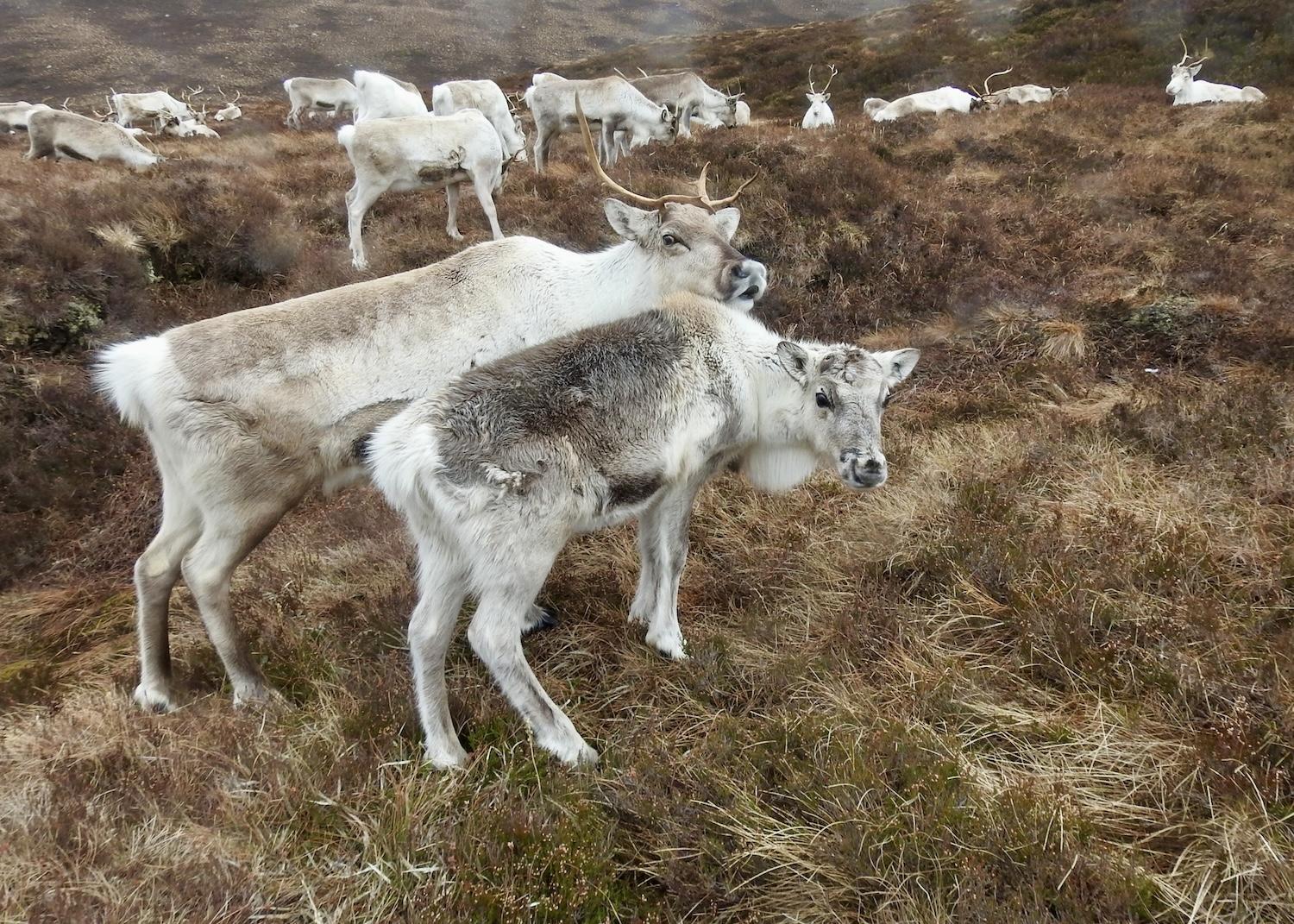
In Scotland's Cairngorms National Park, Britain's only free-roaming reindeer herd includes mom Suebi and son Elbe/Jennifer Bain
Rule number one when hand-feeding Britain’s only free-ranging reindeer herd is not to touch them. It seems impossible because the charismatic animals nuzzle your cupped hands full of feed with their soft, velvety noses. But you must resist the urge to take things one step further and stroke their furry coats, even as they brush up against you and sniff your pockets.
See, reindeer don’t like to be touched. The only time they give each other physical contact is when they’re telling each other off or pushing off other animals to get at food or because they’re too close.
Stroke a reindeer and it will think you’re telling it off. Grab a reindeer’s antler and it will think you’re challenging it to a fight.
“If we start stroking them all, then they’ll walk off and that will be the end of our little reindeer experience,” warns Joe Mann, our Wilderness Scotland guide who also happens to be a seasonal reindeer herder with the Cairngorm Reindeer Herd.
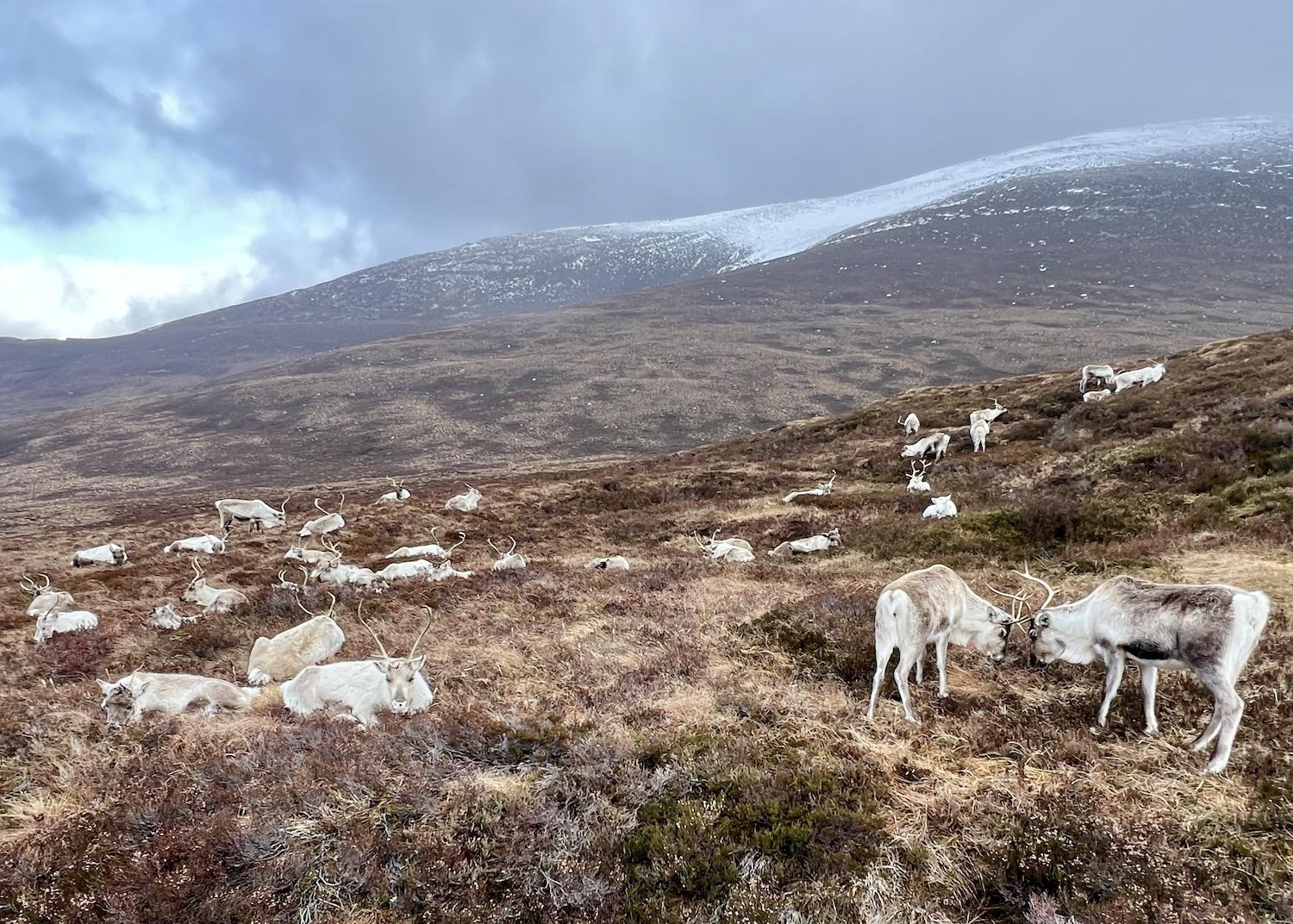
Female reindeer Nuii and Helsinki butt heads as the Cairngorm Reindeer Herd rests on the mountainside in March in the Scottish Highlands/Jennifer Bain
I’ve come to Cairngorms National Park in the Scottish Highlands on a scenic walking trip called “Winter Wildlife.” And while the four-night trip is advertised with the image of shaggy Highland cows — and I do get to pat one named Murdo who lives at the Castle Roy ruins — we get to explore a variety of habitats and learn how different species cope with the Scottish winter.
There will be Whooper swans and Greylag geese on the wetlands day, and Scottish wood ant nests and Goldeneye nest boxes on the Caledonian pine forest day. We’ll learn about salmon along the River Spey and spot grey seals in a tidal lagoon along the coast. But I’m most excited to visit the Cairngorm Mountains.
“We’ll keep an eye out for snow bunting nesting in the northern corries and listen for the distinct call of the ptarmigan traveling through the crisp mountain air,” Wilderness Scotland promises. “You may also spot red deer as well as the free-roaming reindeer — this area is home to the UK’s only herd.”
If you are lucky enough to land Mann as your guide, however, he’ll take you to the Cairngorm Reindeer Herd’s Reindeer Centre, and then on an optional “hill trip” to see them in an unexpectedly arctic-like landscape that reminds me of Nunavut and Greenland.
“This is the coldest place, the most extreme place, the windiest place in Britain,” says Mann after driving us up the Cairngorm Mountain ski area to a remote parking lot.
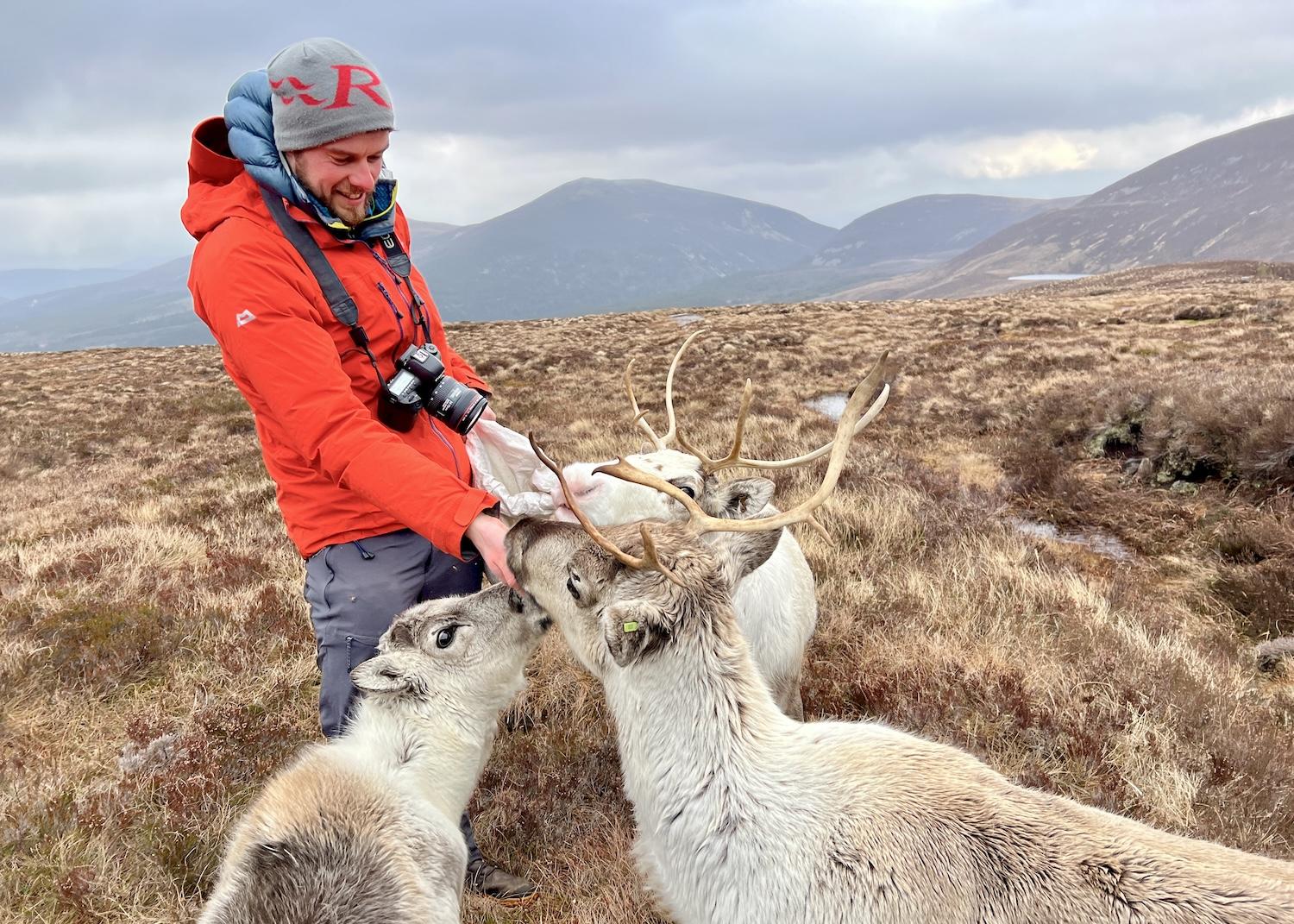
Joe Mann is a guide with Wilderness Scotland, an adventure holiday company, and a seasonal herder with the Cairngorm Reindeer Herd/Jennifer Bain
It has been a mild March and while we can finally see snow, we won’t climb high enough to really experience it. Instead, we’ll walk uphill briefly and then along a rough fence line to find 60-odd reindeer that are tucked out of sight of passersby.
“Once we leave the treeline and get above 500 feet, this is reindeer country now and an arctic tundra-like habitat,” promises Mann.
Reindeer (Rangifer Tarandus) are a gregarious herd animal from the deer (Cervidae) family that live around the globe in arctic and sub-arctic regions. In North America, they’re often called caribou and have been hunted but never domesticated. Reindeer are the same species but were the first animal that people manipulated, herded and domesticated. Several Arctic and subarctic people — including the Sámi and the Nenets — have herded reindeer for centuries, raising them for meat, hides, antlers and milk, and to carry or pull heavy loads. They aren’t fully domesticated and usually roam free on pasture grounds.
Reindeer are believed to be native to Scotland but became extinct 800 to 1,000 years ago due to over-hunting and a lack of habitat. According to the Orkneyinga Saga, red deer and reindeer were once hunted together in Caithness by the Earls of Orkney.
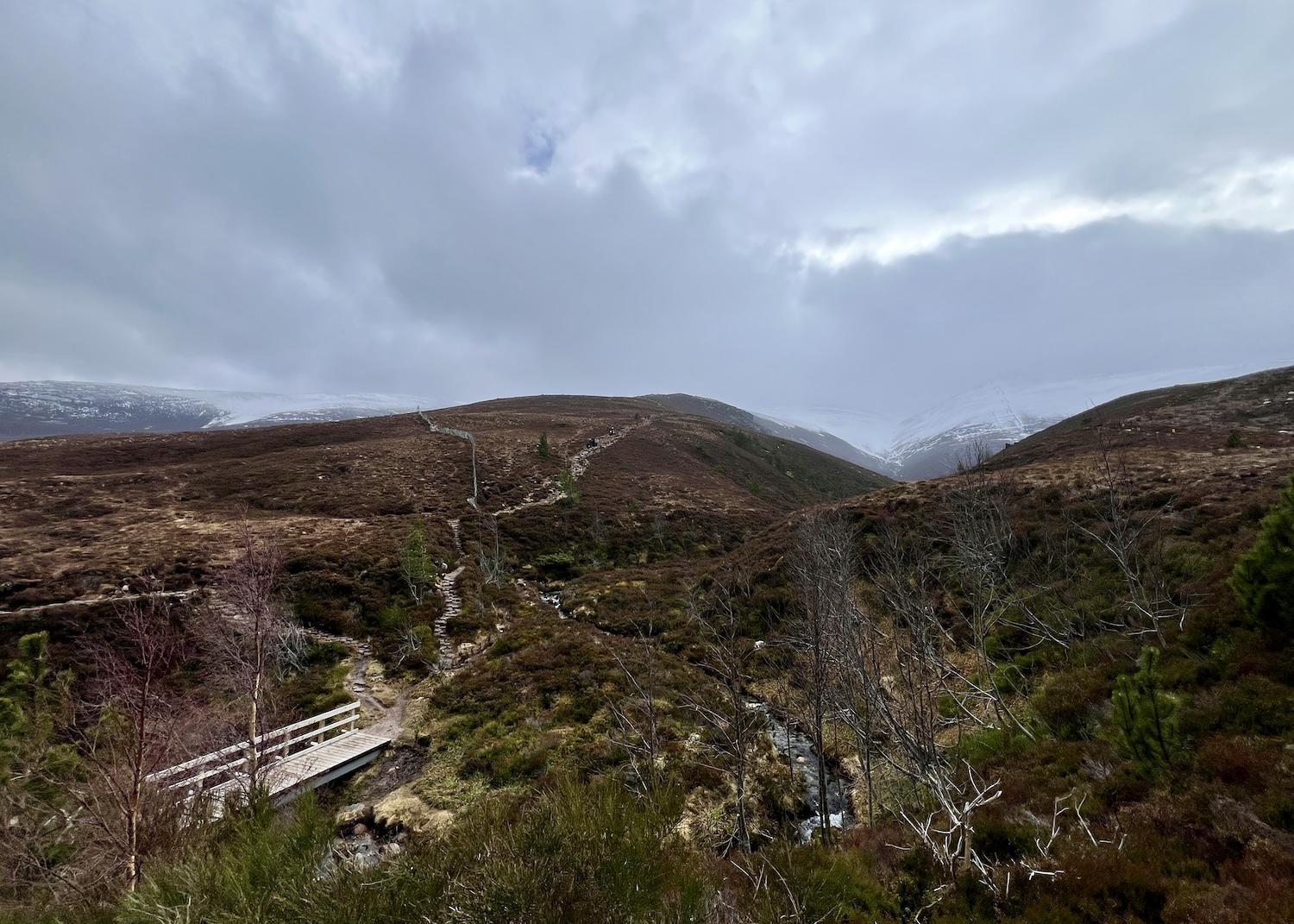
A view of the arctic-like landscape in the Cairngorm Mountains where a free-ranging reindeer herd lives/Jennifer Bain
Fast forward to 1947 and Swedish Sámi reindeer herder Mikel Utsi was honeymooning here with Dr. Ethel Lindgren and was reminded of reindeer pastures in Lapland when he got off the train in Aviemore and saw the Cairngorm Mountains.
“The story goes, the romantic man that he was, he left his wife on their honeymoon for three days, going into the hills, looking for reindeer,” says Mann. “They had to be there. He didn’t ask anyone about it — he just assumed there would be. Of course, he didn’t find any reindeer — they were long gone — but what he did find was a perfect habitat for reindeer to thrive. Loads of lichen, which makes up their sole diet in winter. It was the perfect climate, the perfect temperatures. There were lots of arctic and high alpine plants up on the high tops. There were no predators to see, of course, because wolves and lynx had become extinct. It was just the perfect place for reindeer to thrive.”
By 1952, the couple had permission to reintroduce reindeer to Britain. They founded the Reindeer Company, brought two bulls and five cows by boat from Sweden, quarantined them briefly at Edinburgh zoo, and finally released them to graze on 300 acres of fenced mountain land.
Other reindeer followed. The growing herd grazed in Moormore to establish whether they impacted conifer growth, but by 1954 the forestry commission granted Utsi the use of 1,100 acres on Airgiod-meall (Silver-Mount) on the northern slopes of the Cairngorms. This is where most summer hill visits still take place. The reindeer enjoy another 6,000 acres of free-range grazing on the mountain tops.
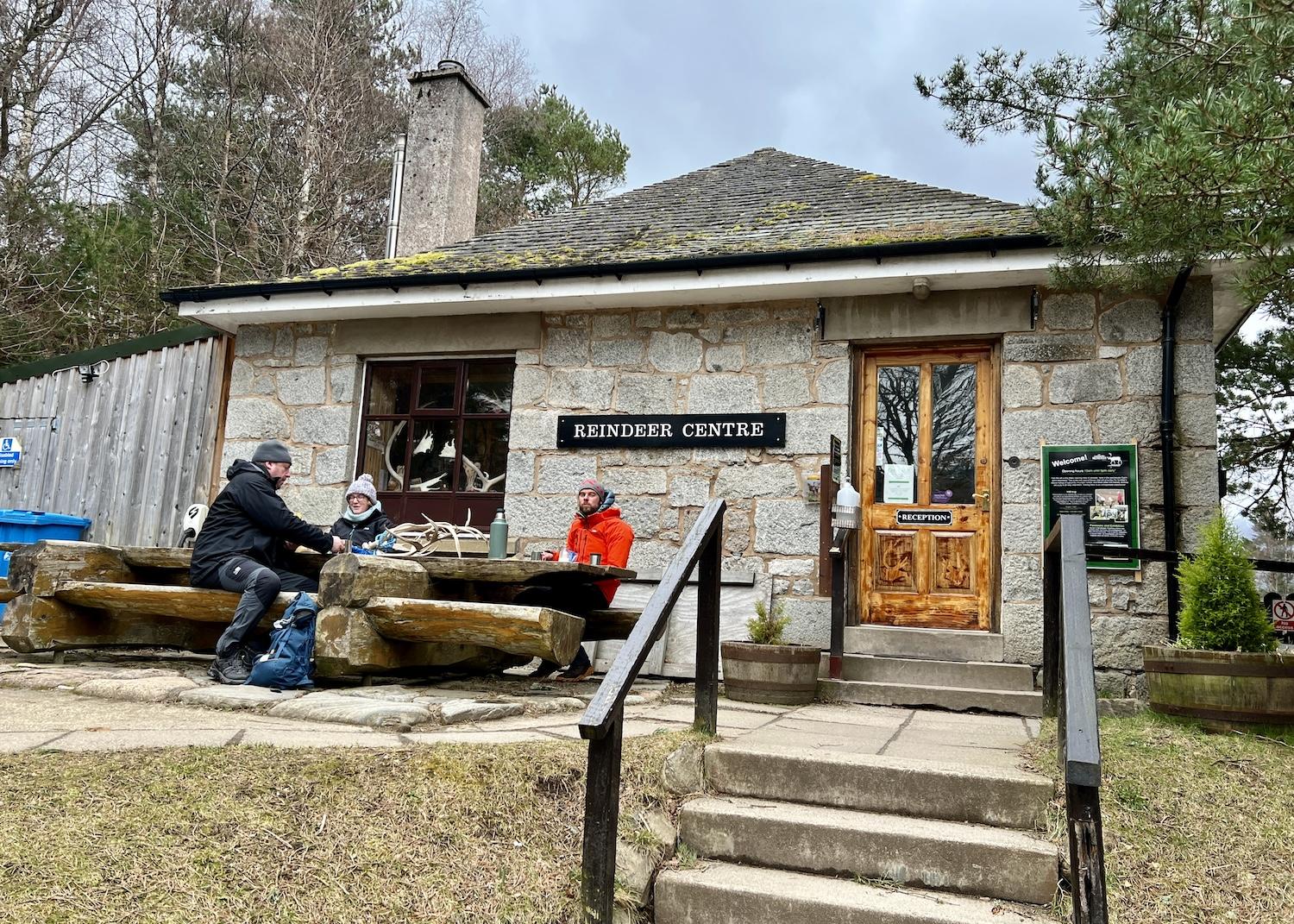
Wilderness Scotland guide Joe Mann, right, leads a picnic at the Reindeer Centre in Glenmore/Jennifer Bain
What began as a plan to raise reindeer for meat quickly became a tourism business with daily hill trips. After Utsi and his wife died, young herders Alan and Tilly Smith purchased the herd in 1989. (Mann is engaged to their daughter Fiona.)
Now most of their 150-odd reindeer range on the Cairngorm Mountains with the remainder 30 miles away on the Glenlivet Estate. You can visit either place and the paddocks/exhibition area at the Reindeer Centre (which is currently being renovated) in the village of Glenmore. There’s a small shop that sells things like antler jewelry and an adoption scheme that has more than 1,000 global supporters. Just before Christmas, some reindeer go on an annual fundraising tour to pull sleighs while raising awareness of the herd.
I should explain that Cairngorms National Park is nothing like American and Canadian parks. Created in 2003, it’s the largest park in the United Kingdom at 4,528 square kilometers (1,748 square miles). About half its land is considered wild, but about 18,000 people live in towns and villages spread across the park and there are no entry fees or gates.
The park draws nearly two million visitors a year. It boasts four of the five highest mountains in the UK, the biggest native forests, rivers, lochs, moorland and farmland. It has 19 areas of conservation, 12 special protection areas and nine national nature reserves. The Cairngorm plateau has the most extensive range of arctic mountain landscape in the British Isles and is described as being more like the arctic than Scotland.
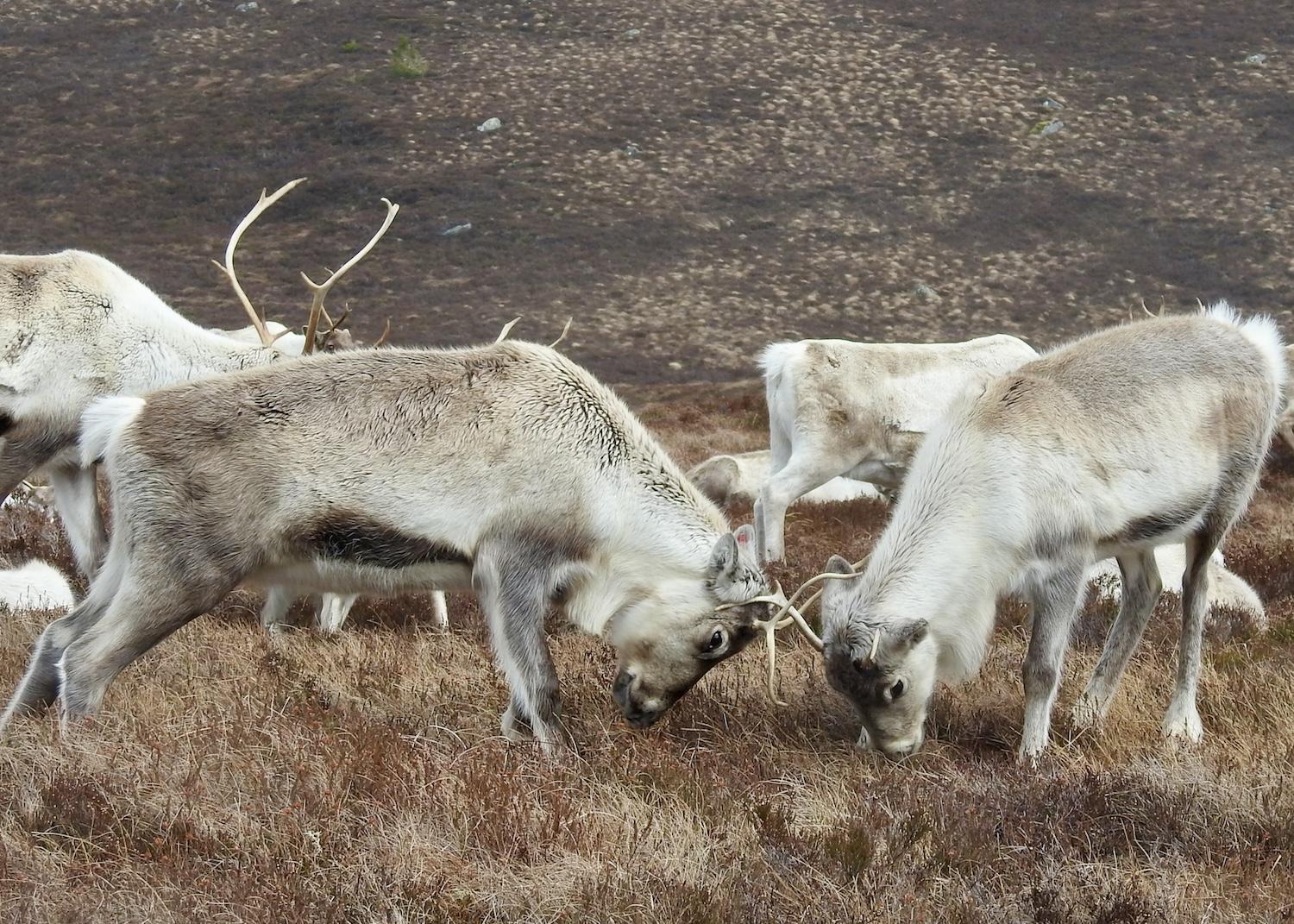
Two female reindeer named Nuii and Mochi butt heads on the Cairngorm Mountains/Jennifer Bain
On the day of my visit, there are 146 reindeer in the herd and they’re kept in two areas to better manage them and prevent disease. Eighty-three males are at the 1,200-acre managing site in Glenlivet in case they’re bullish with guests or try to mate with the females at the wrong time of year. We’ll be looking for the 63 mostly female reindeer and a few calves on the mountain.
“For the vast majority of their life they need to be open air, up in the mountains, living free,” explains Mann. “We’re quite lucky that our reindeer group today isn’t very far away, but some can wander all over that plateau. It’s a huge area. Sometimes we go months without seeing certain reindeer — they can disappear into the mountains.”
In winter, the reindeer stick to the lower slopes where the ground isn’t frozen and where they can still use their oversized, splayed hooves to dig for food.
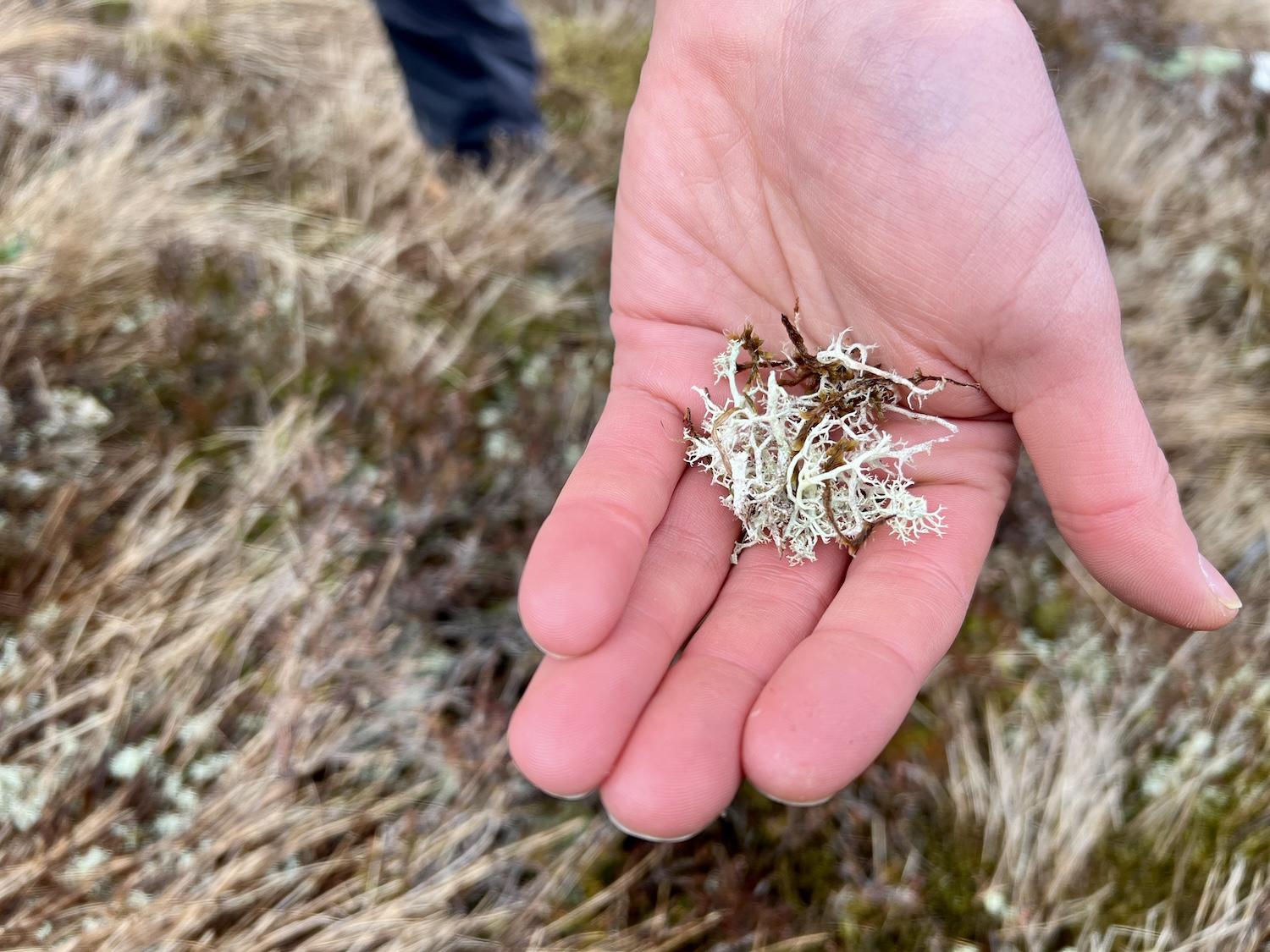
Reindeer moss (aka reindeer lichen) is a reindeer's favorite food and sustains it through winter/Jennifer Bain
As we make our way to the herd, we spot reindeer moss. It looks like reindeer antlers if you break it apart. Reindeer — ruminants with four stomachs — love it and it makes up nearly 90 percent of their winter diet.
“They are constantly regurgitating food and burping,” Mann explains. “It’s likely when we see the reindeer they’ll be chewing the cud as they brought up some of that food and they’re breaking it down, and that’s going to see them through the winter time. Now obviously it’s not super calorific. In the wintertime they’re just surviving, waiting to get through to the summer time where they can eat 100 or so plus plants up here in the Cairngorms.”
We trudge across the wet, almost boggy land that looks healthy and hasn’t been overgrazed. The herd is kept around 150 so the reindeer don’t overgraze and outcompete other wildlife like ptarmigan and mountain hare for food.
Reindeer typically live 12 to 14 years. These animals aren’t culled but are controlled by breeding and usually die of “happy old age.” The herd is small enough to name and get to know each animal.
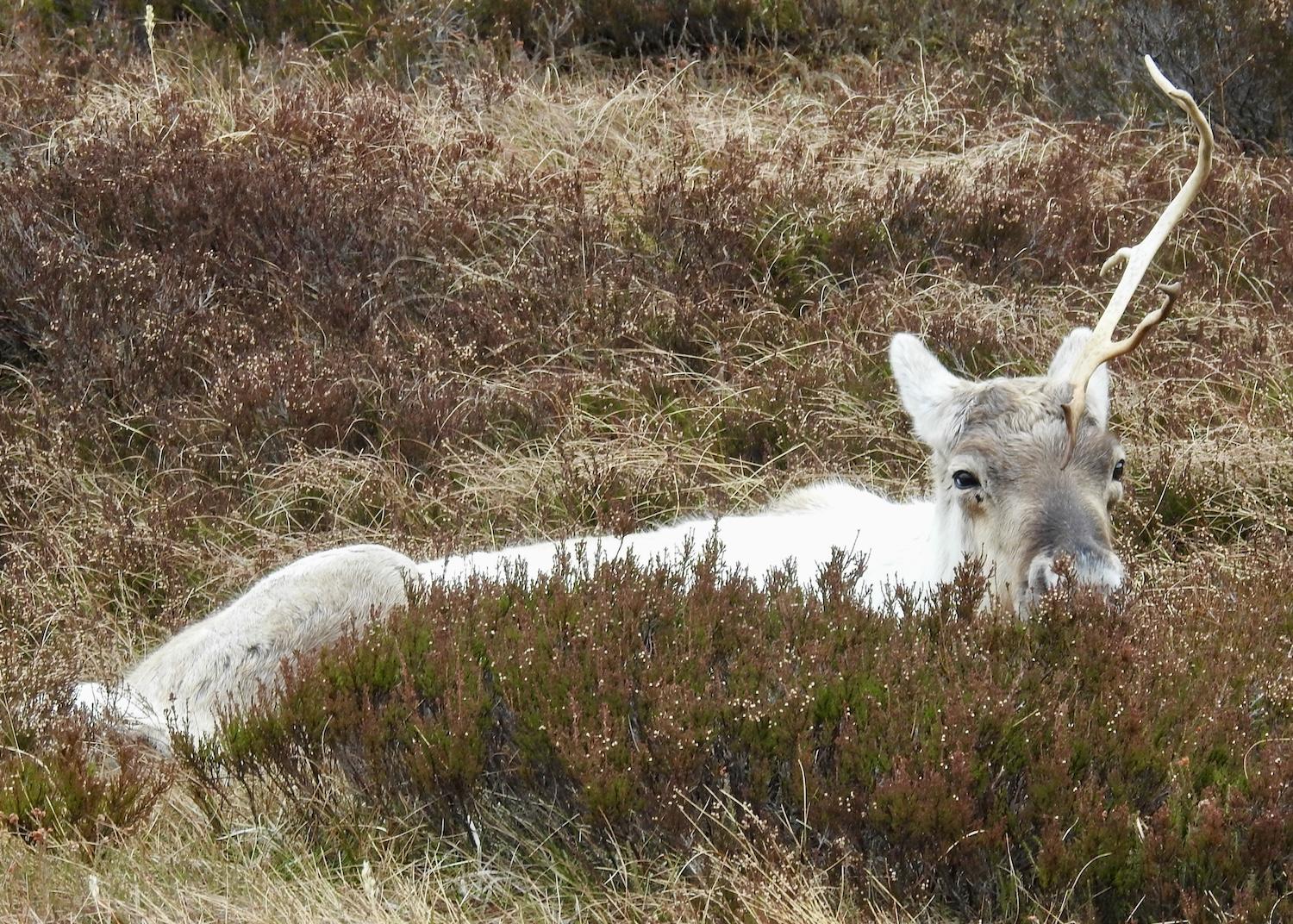
A reindeer named Dante, part of the Cairngorm Reindeer Herd, has one antler/Jennifer Bain
Mann stops every so often to regale us with reindeer factoids and we learn that Scotland is a member of the Association of World Reindeer Herders.
Reindeer have short, dark summer coats and thick, lighter colored winter coats, and come in shades of brown and white. Oversized, shovel-like feet let the animals walk on snow and help them dig for food. All reindeer have a tendon which slips over the bone in the heel causing a “click” sound as they walk. This reduces the need for vocal communication which would waste precious heat in winter.
“It’s an amazing adaptation,” says Mann.
Reindeer start to feel the cold when it hits -30C to -35C, but it doesn’t go below -27C here so, as Mann puts it, “that means our reindeer have never felt the cold in Scotland.”
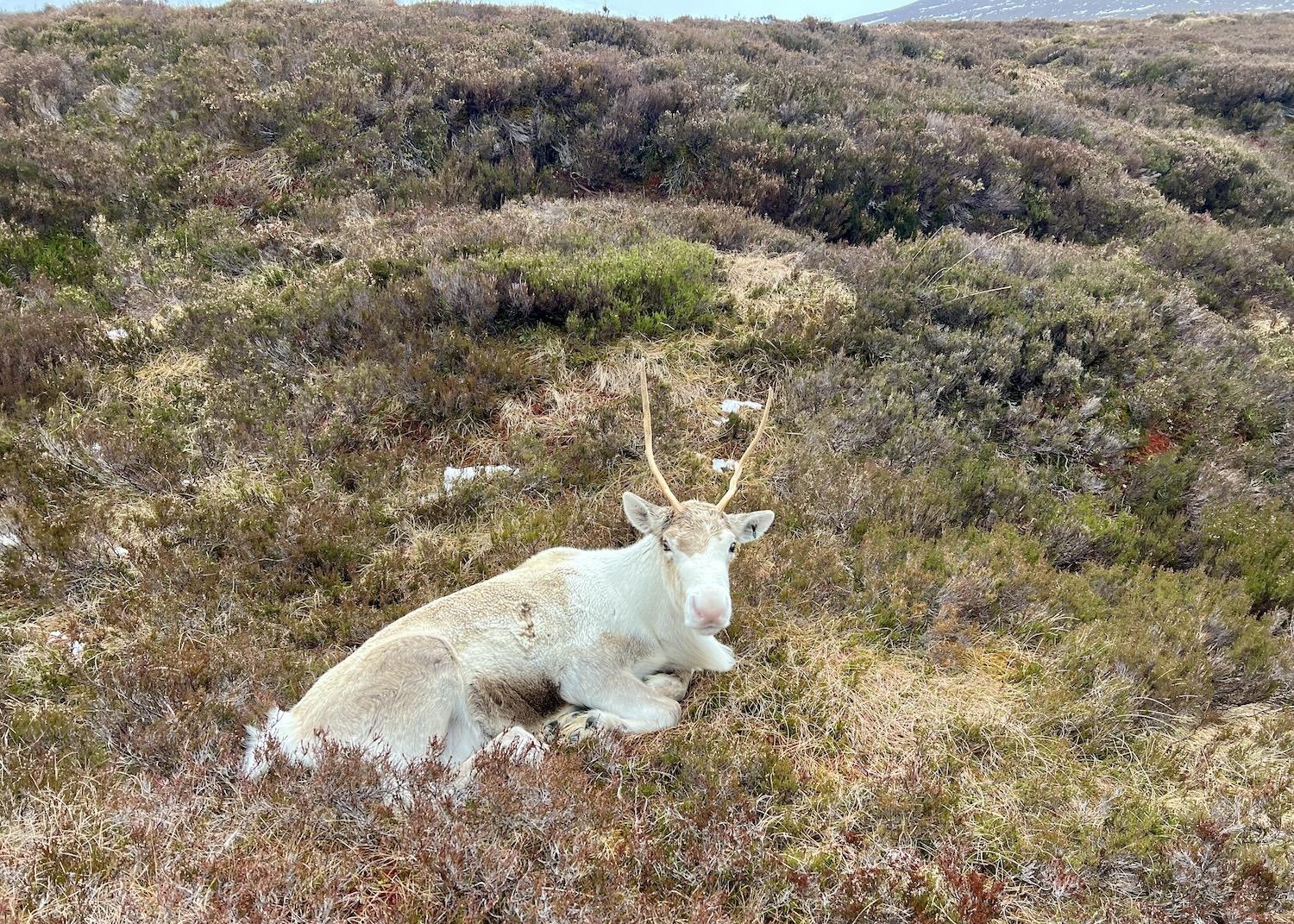
Each reindeer, like Cheer, has a unique set of antlers that serves as its visual "thumbprint"/Jennifer Bain
All reindeer grow antlers made of solid bone. They grow every year, covered at times in a furry skin called velvet that protects the growing bone and carries blood vessels to the tips. When the velvet is stripped away in autumn, it exposes bony antlers which are used for fighting.
Every set of antlers is unique.
“Every single year when they fall off and regrow them again, they’ll grow in the exact same shape once more,” says Mann. “And no other reindeer will have that same shape, so it’s quite an amazing way of identifying reindeer when they’re in the herd.”
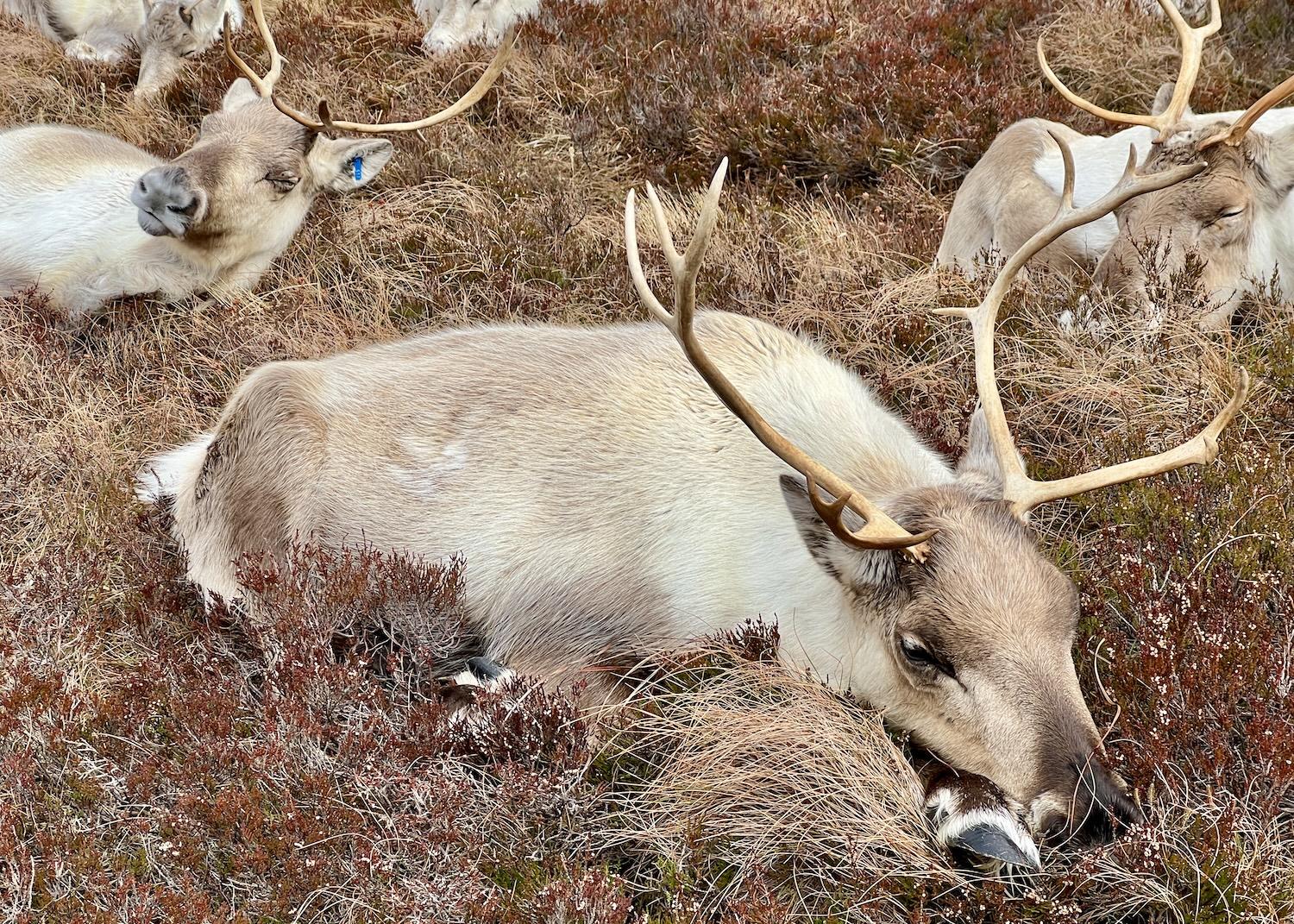
A reindeer named Pip rests on her hooves, while another named Trilby (back left) dozes on her side/Jennifer Bain
Our Wilderness Scotland "herd" numbers four, with me, Mann and fellow adventure holidayers Debbie Robson and Carl Broomhead from England.
We learn that the reindeer get a supplementary feed with different grains, as well as the richer, sweeter treat we’ll give them that combines sugar beets, barley and sheep feed.
“Most reindeer are semi-domesticated, semi-wild, but ours are very, very friendly because we go with food,” says Mann. “Food is basically our bribe but also helps us manage them.”
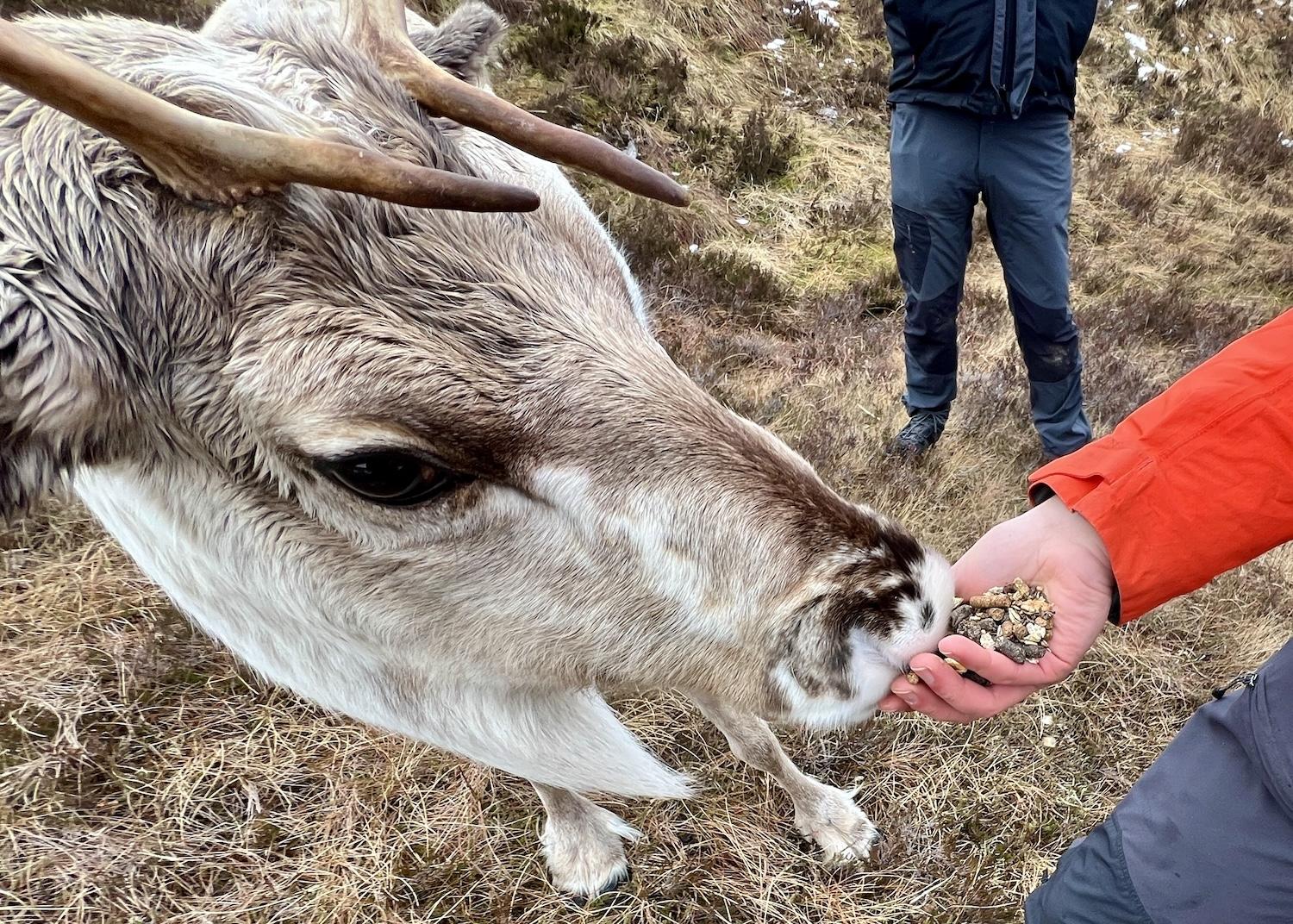
Reindeer herder Joe Mann feeds Ochil, who was named for a Scottish hill/Jennifer Bain
We’re told to cup two hands together and not put them flat like when you’re feeding a horse. This prevents spilling.
“Some of our reindeer have got terrible manners and they’re just going to come flying in for the food,” warns Mann. “Reindeer cannot physically bite you. They’ve got a small set of teeth on their bottom jaw and a flat, gummy palate on the top. They cannot bite your fingers. So hands cupped together and the next thing is to have them far out in front of you and that’s going to prevent any antlers going up your nose.”
We’re asked to “feed the reindeer that’s wanting the food” and not go looking for the reindeer we want to feed. Some reindeer don’t want any human interaction. “The greedy ones will be more than happy to get as much as they can,” Mann accurately predicts.
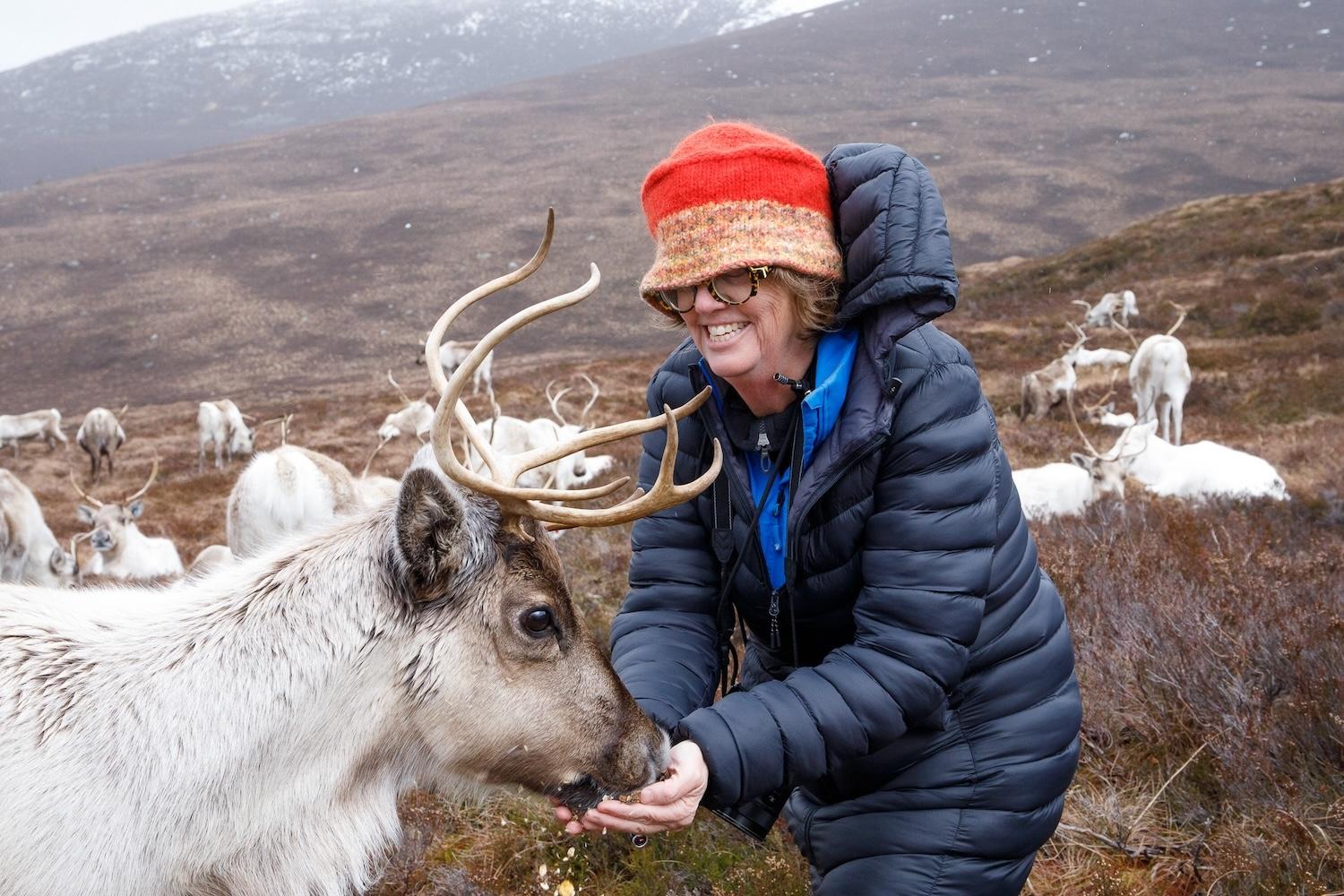
Writer Jennifer Bain feeds a reindeer in the Cairngorms in Scotland while on a Wilderness Scotland "Winter Wildlife" trip in March/Joe Mann
By that he means Texel. Born in 2019 and named for a Dutch island, she has a distinctive patchy white face and is known as the greediest reindeer.
The herders pick themed names each calving season. They have chosen rivers (like Yukon, Nile and Mississippi) and hats (Fez, Sombrero, Beret), ice creams, cheeses and games and puzzles.
“It’s always good fun,” says Mann.
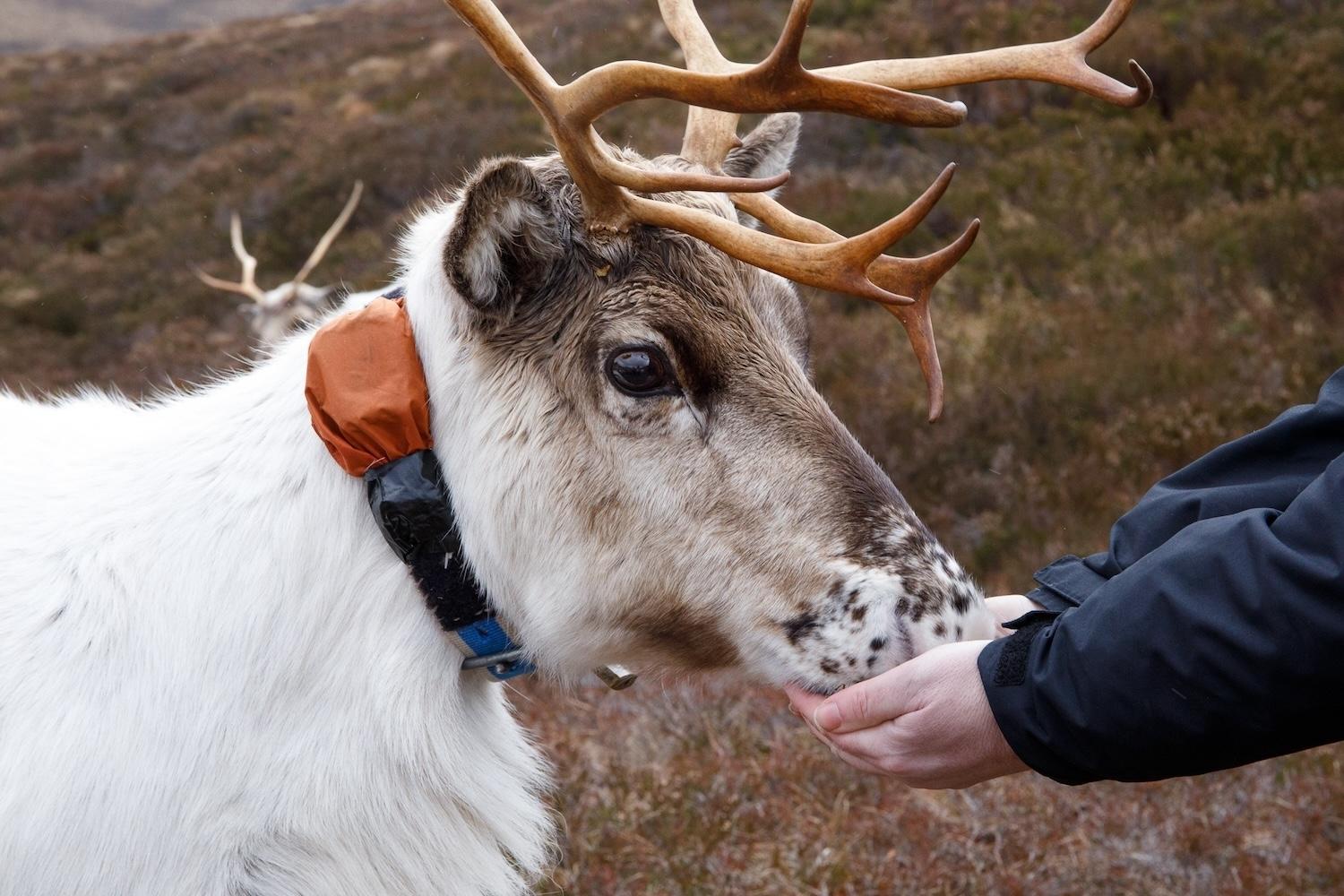
A reindeer named Christie wears a tracking collar so the free-ranging Cairngorm Reindeer Herd can always be found/Joe Mann
With that, he shakes a small feed bag, calls out “lassies” and makes strange herding calls that the animals instantly recognize.
Elbe (a twin who was named for a European river) comes running but he’s too young to feed.
We meet Christie — as in Agatha — who wears a tracking collar so the herders know where to go for the daily hill trips.
We admire Vanilla, who is pure white, and Chickpea who was feared dead when she disappeared for nine months last year but seems to be doing well now.
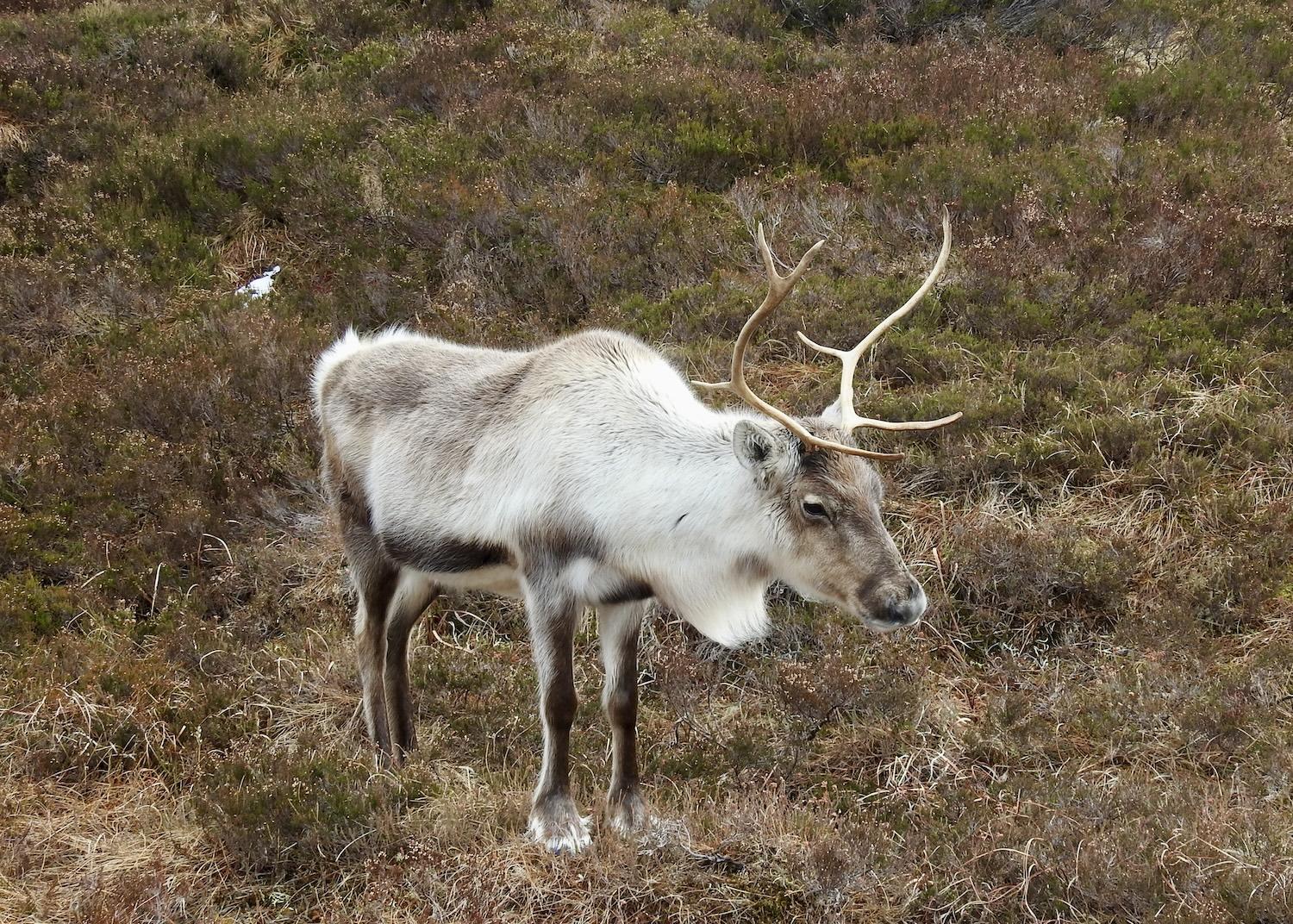
Helsinki seems to have a "sad" vibe, but she's actually relaxed while keeping her distance from humans/Jennifer Bain
We watch Helsinki, who stands alone and looks “sad” but that’s just her demeanor. “Tell me what a happy reindeer looks like,” says Mann. “She’s relaxed, her head is bowed, her eyes are closed and she’s chewing the cud. When a reindeer is stressed, its head is up, it’s wide-eyed and looking rapidly around.”
Only a handful of reindeer come for food. That’s because we have arrived on an unexpected private guided journey — thanks to Mann — on the heels of the public morning hill trip so the herd has just been fed.
“This is the least hungry I’ve ever seen the reindeer,” Mann admits. “Usually they come running.”
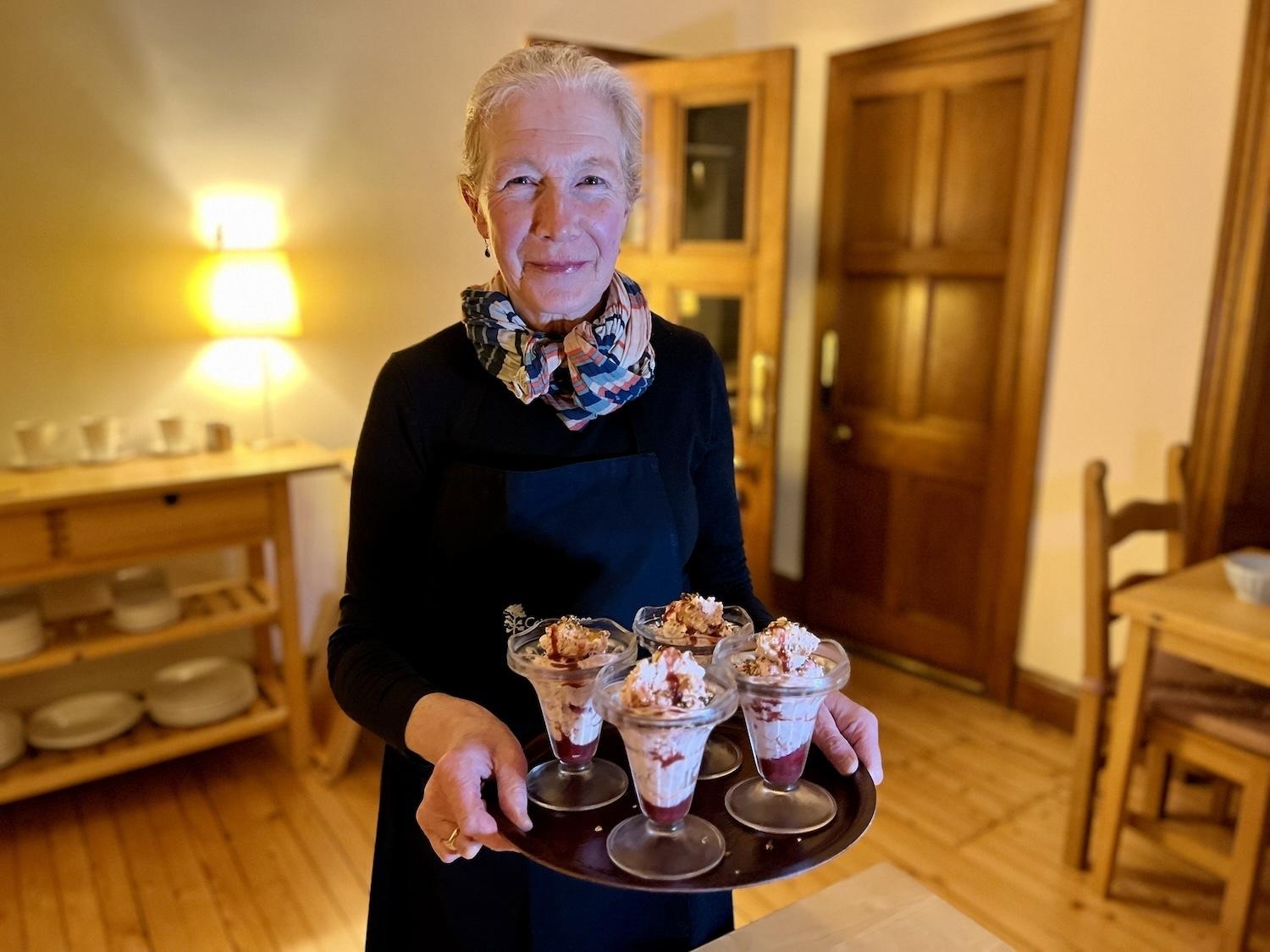
At Coig na Shee guest house in Newtonmore, Marion Broad serves a traditional Scottish dessert called cranachan that's made of oats, cream, whisky and raspberries/Jennifer Bain
We know how they feel. Our home base in the Highlands has been Coig na Shee guest house in Newtonmore, where Marion Broad has stuffed us full of avocado toast and pancake breakfasts, local salmon and venison stew dinners, and Scottish cranachan and ginger parkin cake desserts.
As we run out of feed and reindeer like Pip (whose mom Kipling recently died) lie down and doze, those are our signals to leave.
Making our way carefully back down the mountain on a grey day, talk turns to the plants, grasses, flowers, berries and mushrooms that will soon bloom adding color to the mountain and variety to the herd's diet.
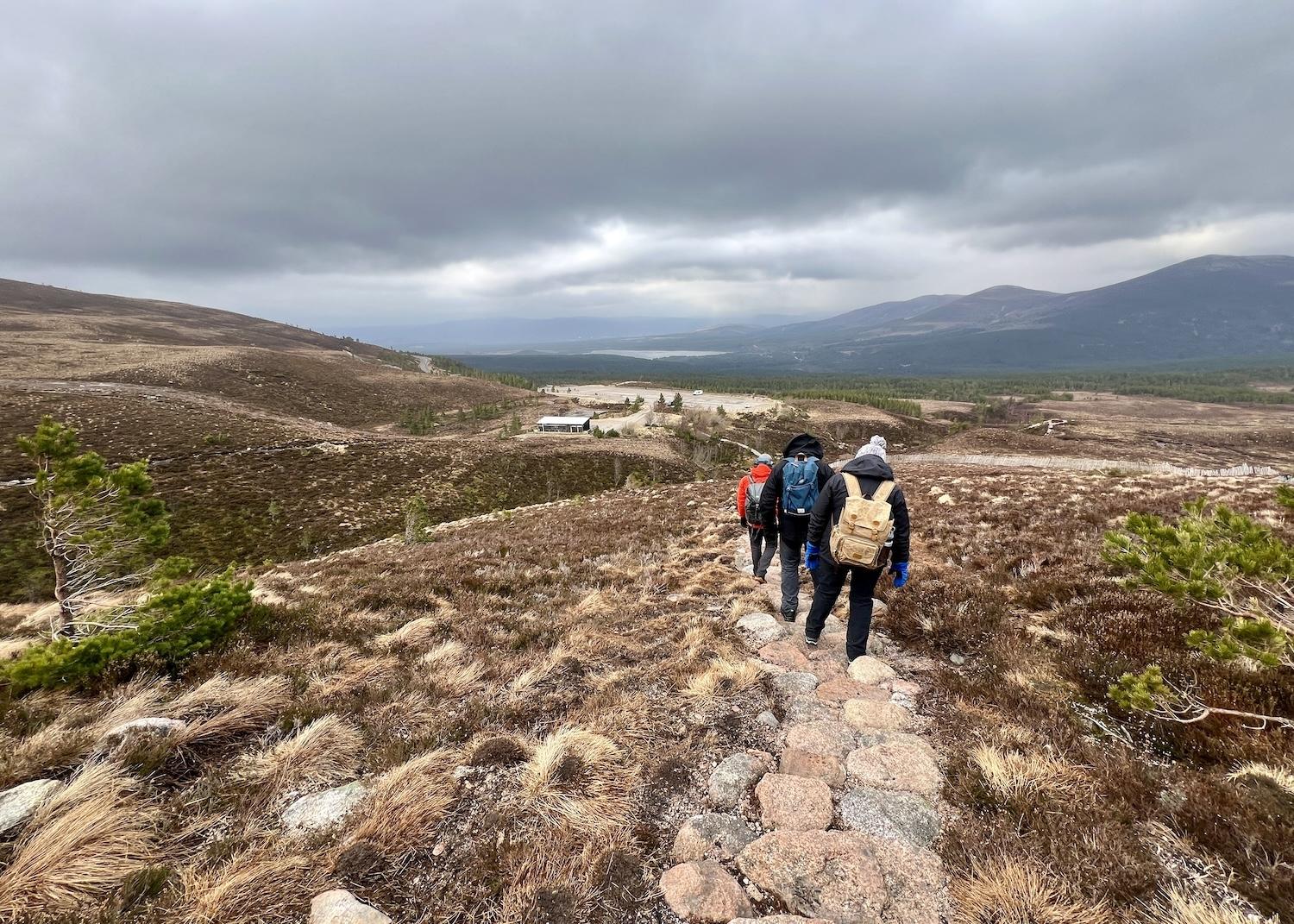
After feeding the free-ranging reindeer in the Cairngorms, our Wilderness Scotland group walks back down to a parking lot not far from a ski hill/Jennifer Bain
Reindeer, it turns out, sometimes gobble poisonous fly agaric mushrooms that are famous for their psychoactive and hallucinogenic properties. “That is the one that really gets them going,” says Mann with a chuckle. “They can ingest them and can get high.”
According to legend that he relays, a favorite pastime in ancient Sámi culture was to drink the pee of reindeer that had eaten the mushrooms for a safe, natural human high. Here in the Cairngorms, the herders don't do that but do occasionally send mushroom-eating animals to “reindeer rehab” and baby them with water and lichen until they feel better.
We don’t get to see any stoned reindeer, but leave riding high after our time with the most interesting creatures in the Cairngorms.
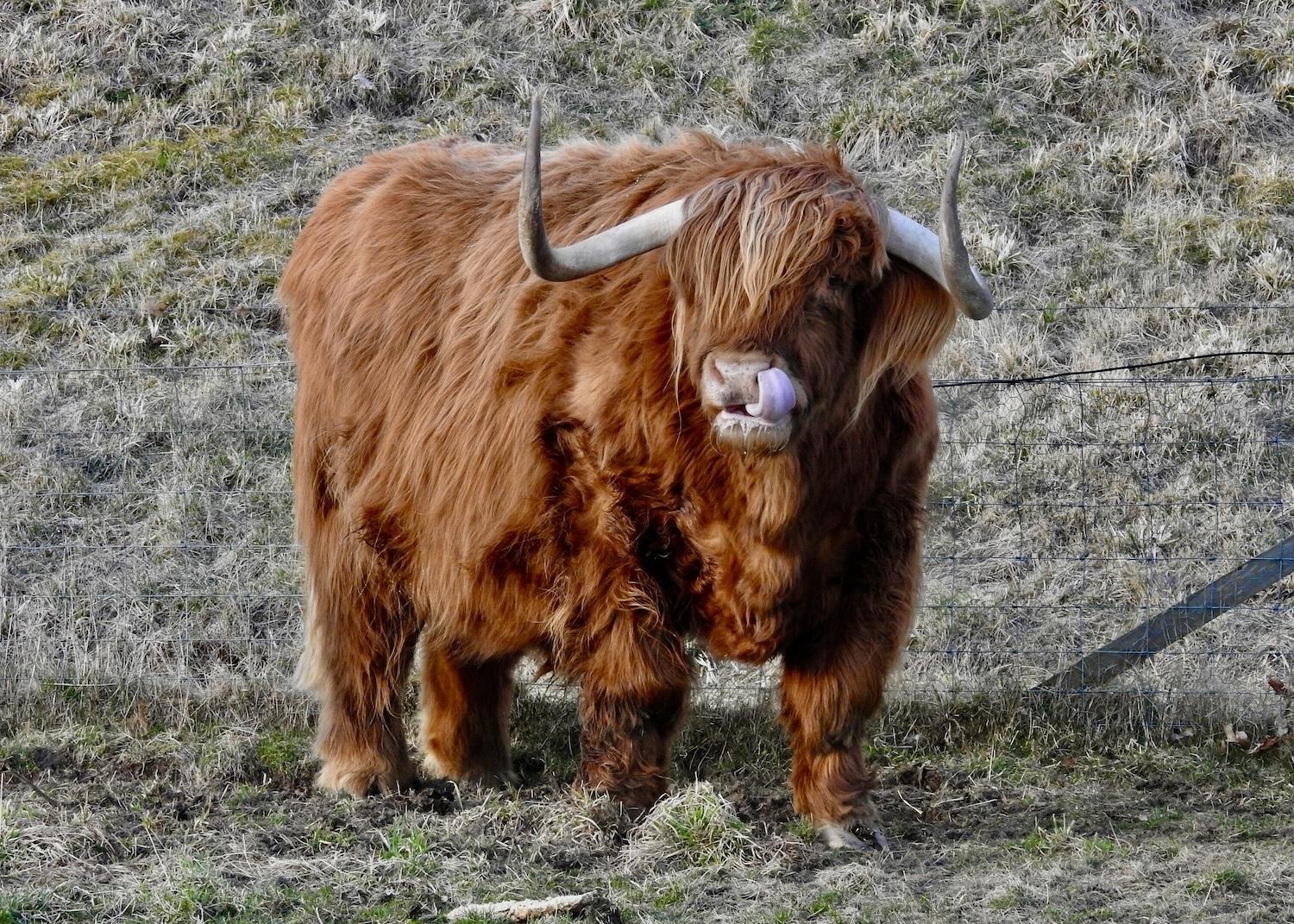
After the free-ranging reindeer, the most interesting mammal we see on Wilderness Scotland's Winter Wildlife trip is Murdo the Highland cow who lives at Castle Roy/Jennifer Bain
